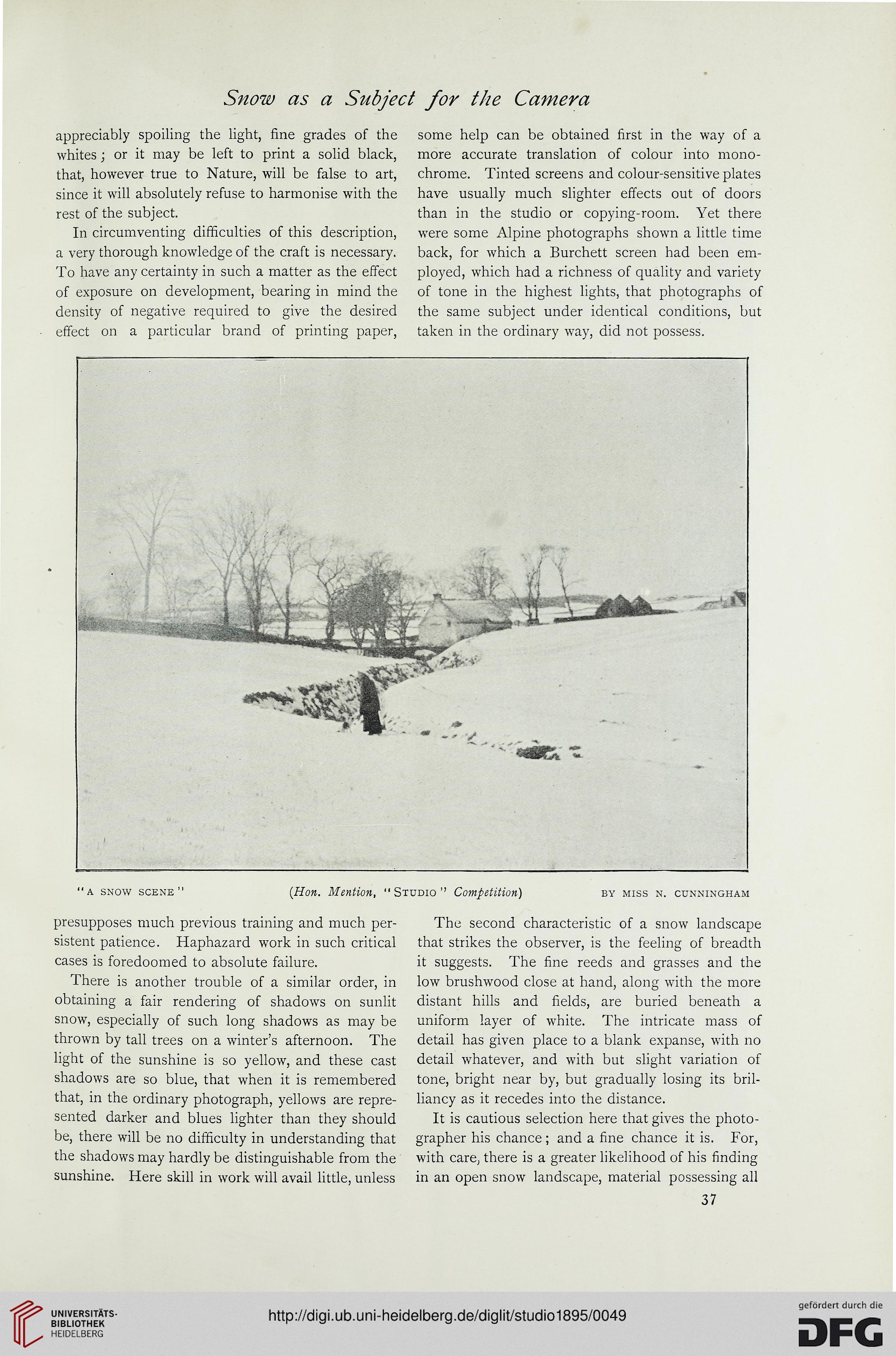Snow as a Subject for the Camera
appreciably spoiling the light, fine grades of the some help can be obtained first in the way of a
whites ; or it may be left to print a solid black, more accurate translation of colour into mono-
that, however true to Nature, will be false to art, chrome. Tinted screens and colour-sensitive plates
since it will absolutely refuse to harmonise with the have usually much slighter effects out of doors
rest of the subject. than in the studio or copying-room. Yet there
In circumventing difficulties of this description, were some Alpine photographs shown a little time
a very thorough knowledge of the craft is necessary. back, for which a Burchett screen had been em-
To have any certainty in such a matter as the effect ployed, which had a richness of quality and variety
of exposure on development, bearing in mind the of tone in the highest lights, that photographs of
density of negative required to give the desired the same subject under identical conditions, but
effect on a particular brand of printing paper, taken in the ordinary way, did not possess.
"a snow scene" {Hon. Mention, "Studio" Competition) by miss n. Cunningham
presupposes much previous training and much per- The second characteristic of a snow landscape
sistent patience. Haphazard work in such critical that strikes the observer, is the feeling of breadth
cases is foredoomed to absolute failure. it suggests. The fine reeds and grasses and the
There is another trouble of a similar order, in low brushwood close at hand, along with the more
obtaining a fair rendering of shadows on sunlit distant hills and fields, are buried beneath a
snow, especially of such long shadows as may be uniform layer of white. The intricate mass of
thrown by tall trees on a winter's afternoon. The detail has given place to a blank expanse, with no
light of the sunshine is so yellow, and these cast detail whatever, and with but slight variation of
shadows are so blue, that when it is remembered tone, bright near by, but gradually losing its bril-
that, in the ordinary photograph, yellows are rep re- liancy as it recedes into the distance,
sented darker and blues lighter than they should It is cautious selection here that gives the photo-
be, there will be no difficulty in understanding that grapher his chance ; and a fine chance it is. For,
the shadows may hardly be distinguishable from the with care, there is a greater likelihood of his finding
sunshine. Here skill in work will avail little, unless in an open snow landscape, material possessing all
37
appreciably spoiling the light, fine grades of the some help can be obtained first in the way of a
whites ; or it may be left to print a solid black, more accurate translation of colour into mono-
that, however true to Nature, will be false to art, chrome. Tinted screens and colour-sensitive plates
since it will absolutely refuse to harmonise with the have usually much slighter effects out of doors
rest of the subject. than in the studio or copying-room. Yet there
In circumventing difficulties of this description, were some Alpine photographs shown a little time
a very thorough knowledge of the craft is necessary. back, for which a Burchett screen had been em-
To have any certainty in such a matter as the effect ployed, which had a richness of quality and variety
of exposure on development, bearing in mind the of tone in the highest lights, that photographs of
density of negative required to give the desired the same subject under identical conditions, but
effect on a particular brand of printing paper, taken in the ordinary way, did not possess.
"a snow scene" {Hon. Mention, "Studio" Competition) by miss n. Cunningham
presupposes much previous training and much per- The second characteristic of a snow landscape
sistent patience. Haphazard work in such critical that strikes the observer, is the feeling of breadth
cases is foredoomed to absolute failure. it suggests. The fine reeds and grasses and the
There is another trouble of a similar order, in low brushwood close at hand, along with the more
obtaining a fair rendering of shadows on sunlit distant hills and fields, are buried beneath a
snow, especially of such long shadows as may be uniform layer of white. The intricate mass of
thrown by tall trees on a winter's afternoon. The detail has given place to a blank expanse, with no
light of the sunshine is so yellow, and these cast detail whatever, and with but slight variation of
shadows are so blue, that when it is remembered tone, bright near by, but gradually losing its bril-
that, in the ordinary photograph, yellows are rep re- liancy as it recedes into the distance,
sented darker and blues lighter than they should It is cautious selection here that gives the photo-
be, there will be no difficulty in understanding that grapher his chance ; and a fine chance it is. For,
the shadows may hardly be distinguishable from the with care, there is a greater likelihood of his finding
sunshine. Here skill in work will avail little, unless in an open snow landscape, material possessing all
37




